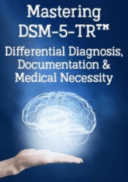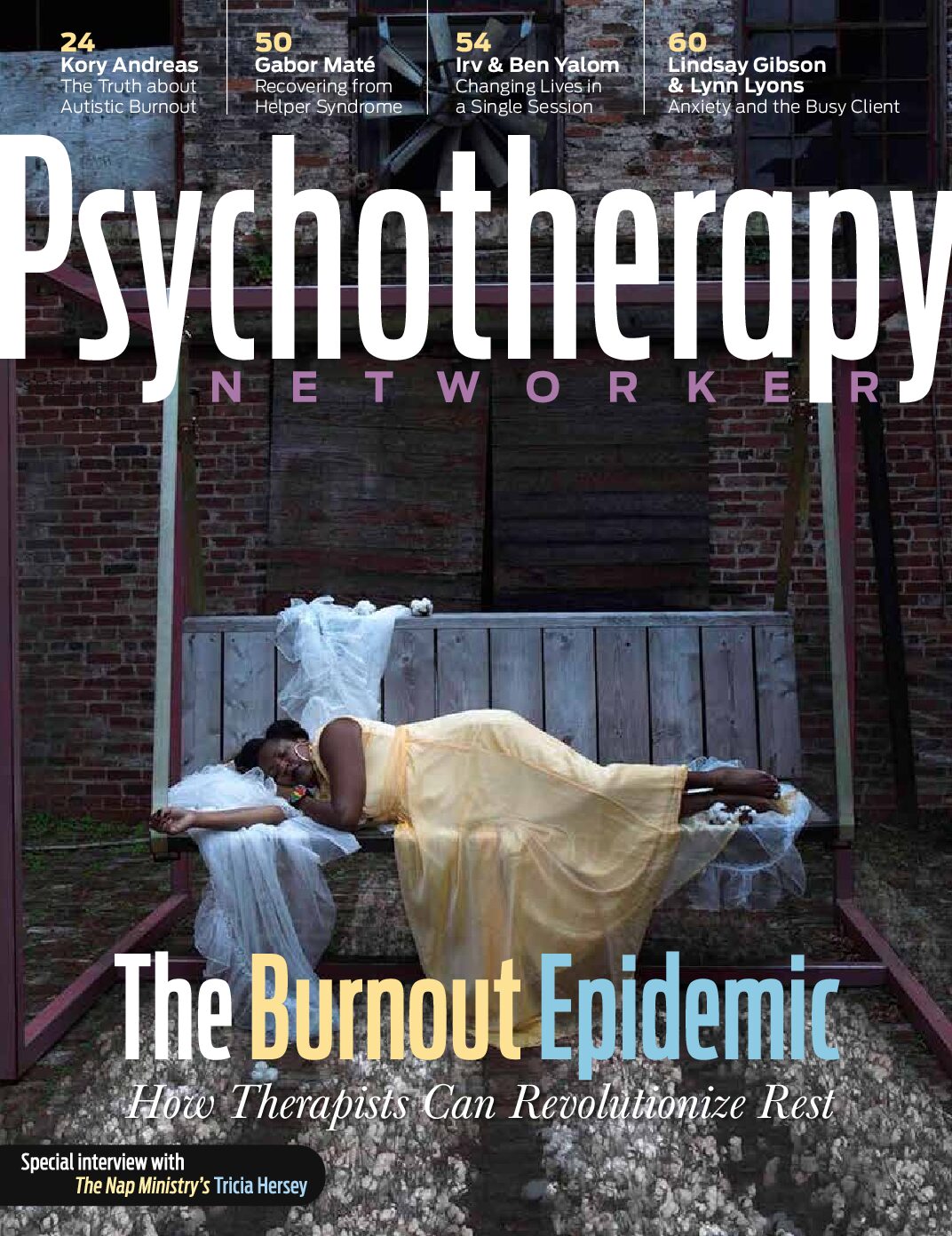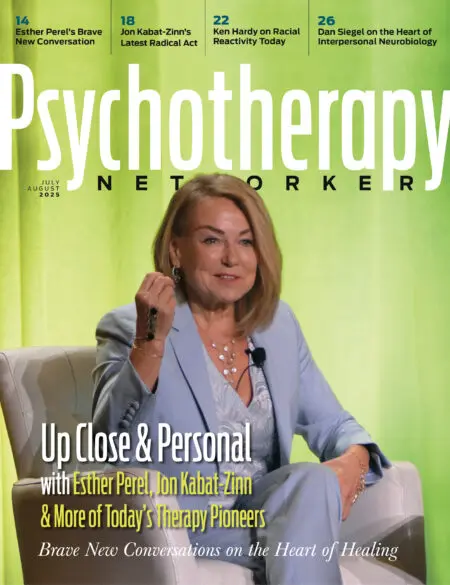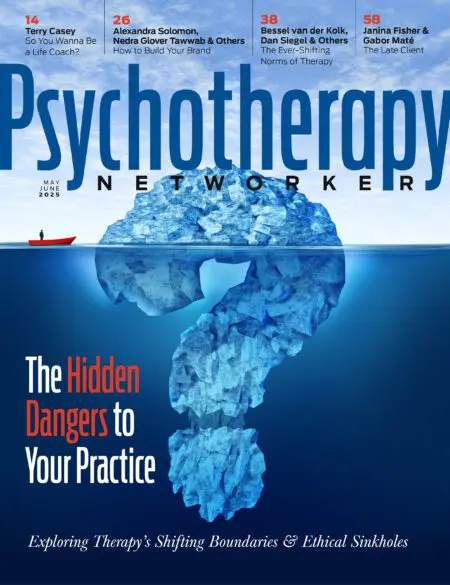Enjoy the audio version of this article—perfect for listening on the go.
As front-line workers in mental health, therapists face a unique challenge we don’t talk about enough in our field. Ironically, when it comes to processing the grief and emotional overwhelm that result from tragedies like a client’s suicide, we’re often hamstrung and isolated by the very HIPAA privacy regulations and ethical guidelines meant to protect clients and uphold professional standards. We’re also undermined by widespread assumptions about the amount of power we have to predict or prevent our clients’ or colleagues’ actions. The aftereffects of this isolation can linger for years, making therapists vulnerable to burnout and mental health problems, sometimes to the point of prematurely ending their career.
Mary stood up to stretch before her next client in the community clinic where she works. There’s never enough time to eat and get notes done, she thought, picking up her phone and scrolling absentmindedly through a few texts. Someone had left a voicemail, and she decided to check it. “Hi, uh, you don’t know me, but I’m Bethany’s sister. I wanted you to know she died by suicide on Tuesday. I’m sorry. It took me a minute to find your number. Bye.”
Mary sank into her desk chair. Her phone dropped from her hand and bounced as it hit the keyboard. Why did that sound so loud? Did anyone hear? Her face was buzzing. She held her breath. Was this really happening? She’d just seen Bethany on Monday. She’d seemed okay. What went wrong?!
Instead of crying and throwing up, like she wanted to do, she scrambled to compose herself before her next client arrived. Two minutes. I have two minutes to pull myself together. She could hear her own heartbeat in her ears as she reached for her water bottle. She took a sip, which only intensified her nausea. Impulsively, she placed her phone on do-not-disturb, shoved it into her desk drawer, and squeezed both hands into tight fists, as if doing so would condense the shock reverberating through her body. Then she heard footsteps, followed by the hallway door opening. Time was up. She stepped into her waiting room and invited her next client into her office.
Somehow, Mary made it through her final two sessions of the day despite feeling completely disconnected from anything happening outside her body. She tried to listen to her clients, but her mind kept replaying her last session with Bethany. Although Bethany had seemed jittery, Mary hadn’t noticed anything out of the ordinary about her words or behavior. In fact, they’d been making progress. Bethany had even mentioned looking forward to seeing her family at the end of the week for a much-needed break. What was going on? Mary kept wondering.
She knew she needed to call Jordan, her clinical supervisor. It looks bad that I waited so long to reach out to him, she thought.
“Everything okay?” Jordan asked after picking up the phone.
“No, actually,” Mary said, her voice sounding strangely robotic to her own ears. “I got a voicemail that one of my clients died by suicide.”
Jordan paused. In the silence, Mary took a deep breath, trying to ground herself by pressing her feet against the floor.
“Did you assess her for suicide?” he finally asked, his tone urgent in a way Mary interpreted as critical. Her voice shook as she responded that she hadn’t. “Let’s meet early Monday morning,” he said. “We’ll go over your final session with her and take a closer look at your notes.”
Mary’s nausea resurfaced as she hung up the phone. Did I miss something that could have prevented this from happening? Will they fire me? What if they revoke my license? Do I go to the funeral? Is her family going to sue me? The panic crawled up Mary’s throat and constricted her breath.
Although she was done with her workday, she didn’t want to go home. The prospect of being alone with her thoughts all weekend was terrifying. She considered calling a coworker but hesitated. What if they think I’m a bad therapist? What if they tell other people in the clinic? What if I don’t get any more referrals? As Mary got to her car and shut the door, the tears came, along with a rush of thoughts she’d been trying to keep at bay. It’s my fault. I did this to Bethany. I’m sorry, I’m so sorry, she repeated. Hunched over the steering wheel, she began sobbing. She felt utterly alone.
But Mary wasn’t alone—at least not in the sense of being the only clinician who’s had this kind of an experience. In fact, one in four therapists will have a client die by suicide and—within 28 minutes—convince themselves they’re responsible for the death, regardless of other factors or circumstances surrounding the event.
Suicidologist Rachel Gibbon calls this a delusional narrative, one that can be enormously damaging for a therapist, emotionally and professionally. The solution may seem obvious: therapists who experience job-related tragedies need other therapists to compassionately help them move through grief and overwhelm. But this is where it gets tricky—mental health professionals tend to overestimate their ability to predict and prevent self-harm in clients, which can make genuine compassion for their colleagues hard to come by in these situations.
Adverse Psychological Events (APEs)
We’ve all heard of Adverse Childhood Experiences (ACEs)—traumatic events that occur in childhood that can negatively impact people over the course of their lives. Mary’s experience is an Adverse Psychological Event (APE), a term we’ve coined in the mental health field that can include client violence, client sudden death, client suicide, subpoenas, and public client grievances.
Due to HIPAA privacy rules and ethical licensure guidelines, therapists are often limited in how they can talk about an APE. And even if they could share their experience freely with colleagues, most wouldn’t risk feeling judged, blamed, shamed, and possibly ostracized by their community. It’s a familiar trap that clinical researcher Lena Salpietro has termed confidential grief. And it’s how many therapists end up doing the very things they know only make grief and trauma worse: they isolate themselves, bury their feelings, stay quiet, ignore their symptoms, and minimize their distress.
Although most mental health professionals can relate to the pain of an APE, the experience itself can vary widely. Maybe your worst moment was being hugged and kissed by a client without your consent. Or perhaps, like Mary, you’ve lost a client to suicide, or to a drug overdose. Maybe you’ve been subpoenaed, and your actions were put under a microscope. Maybe you’ve been reported to your licensing board by a professional colleague or supervisor, or had a grievance filed against you by your licensing board.
The worst moments of our careers can make us question our clinical competence. Over time, they can dovetail with our own insecurities, snowballing into an avalanche of self-doubt that demolishes our confidence with our clients. Unchecked, they lead to burnout, often ending the promising careers of compassionate, caring, and skilled clinicians.
The APE in the Room
Following the devastating voicemail message from Bethany’s sister, Mary barely ate or slept all weekend. With no one to help her contextualize her experience or counter her self-blaming thoughts, she’d convinced herself that she was an inherently bad therapist who’d made a terrible, unforgiveable mistake.
When she reluctantly walked into her community clinic on Monday morning, she was lightheaded with exhaustion. She was also experiencing physical numbness, queasiness, ruminating thoughts, and depersonalization.
Entering Jordan’s office, she fought back tears as he ushered her into a chair. “Let’s take a look at your notes to see what happened,” he said by way of greeting, oblivious to her distress. He seemed to be speaking to her from far away. Am I about to faint? She wondered. Why doesn’t he just fire me or report me for malpractice and put me out of my misery? She felt paralyzed.
As would any other traumatic experience, an APE can affect a clinician physically, emotionally, relationally, mentally, and spiritually. From an anonymous survey of over 200 mental health colleagues, we know that each APE a clinician experiences results in anxiety. Other impacts include sleep disruption, hypervigilance, gastrointestinal issues, muscle tension, chronic pain and stress, elevated heart rate and blood pressure, hair loss, headaches, migraines, and tearfulness.
Clinicians may feel sorrow, sadness, and despair as well as anger, fear, guilt, and shame. Some feel shocked, which can show up as dissociation, denial, numbness, detachment, confusion, or disorientation. Additional emotional responses include embarrassment, overwhelm, panic, and hopelessness. Relational symptoms include disconnection from others, loss of trust, humiliation, withdrawal, avoidance, hyperindependence, martyrdom, and a decline in the quality of current relationships and a reluctance to form new ones.
It takes awareness of all these factors—and of the context in which APEs occur—for mental health professionals to recognize and manage physical, emotional, and behavioral symptoms in healthy, adaptive ways.
Sharing Our APEs
Mary responded to her supervisor’s questions as best she could, but felt protective and defensive about her work the whole time. As they finished the meeting, he told her their next step might be to have a conversation with the malpractice lawyer, which only served to keep Mary imagining the worst. Although lawyers were never mentioned again—and her supervisor just seemed to move on from the whole event without looking back—Mary continued to blame herself for the suicide and lay awake most nights wondering if Bethany’s family blamed her too.
Two months later, she was still consumed with worry and remained on edge, wondering which of her clients might engage in self-harm, or die of suicide, next. She had no appetite and lost weight, wasn’t sleeping—and through it all, she only spoke about what happened in the most opaque, general terms. Mostly, she told her family, friends, and coworkers that “work is stressful right now.” They all sensed she was struggling with something difficult but hoped it would pass.
As time wore on, although Mary wasn’t fired, she found herself wanting to quit from the immense physical and psychological stress she felt. Her best friend suggested she talk to her supervisor about her feelings, but Mary suspected she’d only be met with more judgement and maybe even feel shame for not managing her own responses better. After a few years, Mary made a career shift. She left a job she once loved to pursue a career in market research, which interested her just enough to get her through the days but carried no extra emotional weight.
The sad truth is, it didn’t have to be this way for Mary. We can reduce the risk of therapists burning out and leaving the field after an APE through empowered leadership. We can support graduate students and new clinicians by talking openly about APEs and normalizing that all clinicians will experience one or more worst moments over the course of their careers. We can start speaking more openly about our own worst moments, so others know they’re not alone. Talking about career-altering, shame-inducing incidents with people who validate and understand what we’re going through reduces the emotional charge of these common experiences. It helps us recover.
What if, instead of blaming or shaming ourselves and one another, we had safe spaces in which to talk about the worst moments of our careers? What if Mary’s supervisor had responded differently when she’d shared her experience with him? What if he’d asked her how she felt and what kind of support she needed? What if he’d even connected her with someone—a colleague or a therapist—trained in helping clinicians struggling with confidential grief?
What if graduate programs better prepared aspiring clinicians to expect and deal with APEs, so as not to fall into the trap of confidential grief? What if we could join a specific APE group for clinicians, where we could experience abundant compassion and zero judgement from our colleagues? Given permission to share what we struggle with professionally, we can cultivate the resources we need to heal without shame.
Khara Croswaite Brindle
Khara Croswaite Brindle, MA, LPC, ACS, CFT, is a mental health leader, professor, published author and confidential grief specialist. When she’s not writing her next book, she’s creating safe spaces for therapists to heal from APEs, burnout, leadership trauma, and money shame.
Ashley Charbonneau
Ashley Charbonneau, LCSW, LAC, ACS, is an evaluator, consultant, trainer, supervisor, and professor located in Colorado. She conducts research on career-altering events and has hope for the next generation of professionals within the mental health field.














